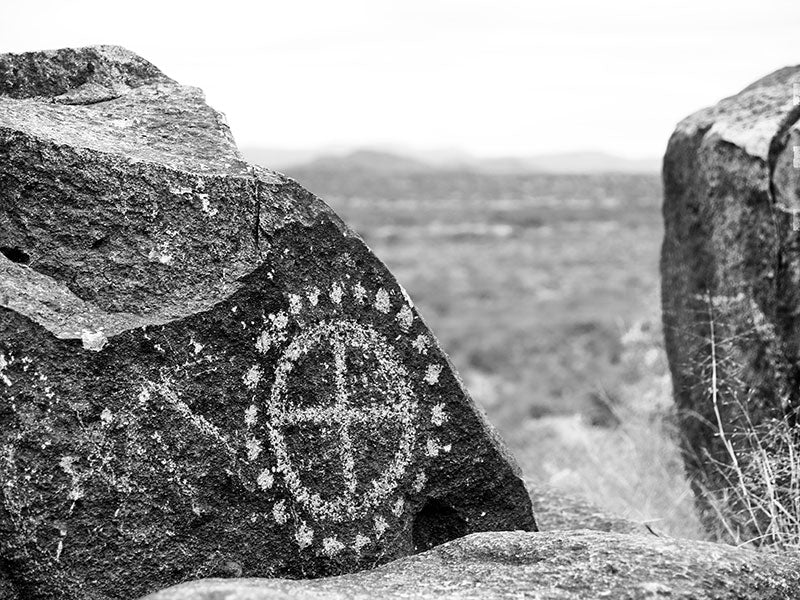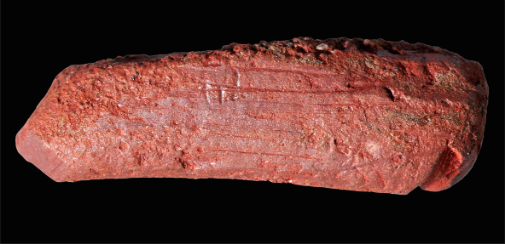
Art-making is a deeply rooted human impulse that goes back to the dawn of time
Humans have a deeply innate need to make a mark—to create art and also to be surrounded by art. From every child who picks up a crayon to the earliest ochre markings in the caves of Europe, art creation is a human urge almost as strong as the need to survive itself.
This 10,000-year-old sharpened piece of red ochre is an early form of artist tool, discovered in the UK. Photo by Paul Shields/University of York.
This week, a small red ochre crayon believed to be 10,000 years old was discovered by archaeologists in England. The earliest artistic markings include scratched lines on ochre stones that are more than 70,000 years old. The oldest known cave art is more than 40,000 years old.
These were times when life was hard and survival was a daily challenge, yet people expended the time and effort to source the ochre, to venture deep into the darkness of caves, sometimes crawling through tiny, winding shafts into nether regions to make wondrous pictures that still enchant today. In some cases, cave sites were used over unbelievably long periods of time—literally eons.
The purpose of this early art may have been religious. It may have been a form of story-telling. It may have been part of ceremonies to encourage better hunts. But almost certainly, at least some of the motivation was the same as it is now . . . it was an urge to create in order to help us better understand our place in the world.
The urge to tell a story
Much of art is related to a narrative. We humans are story-tellers. From the stained-glass windows of European cathedrals that helped communicate Biblical parables to illiterate parishioners to today's barrage of illustrated / animated / interactive everything, art has always been part of communication.
Native American petroglyphs at Mesa Verde, Colorado. Click to buy this fine art photograph.
These petroglyphs at Mesa Verde, Colorado tell the story of the separation of two early clans of Hopi from other people, and their return to their place of origin near the Grand Canyon (marked by the rectangular spiral near the hand shapes). It seems the Native Americans never intended these petroglyphs to last forever, and instead expected them to erode and return back to Earth.
As with the Hopi, art gives a context to our understanding of the world. It contributes to our culture. It aids with perspective and understanding. It helps us identify ourselves and our community. At its best, art is inspirational and aspirational.
The urge to make a mark
Aside from the aspirations of "ART," humans seem to have a need to make a mark that serves no other purpose than to say "I was here." In his brilliant documentary, “Cave of Forgotten Dreams,” Werner Herzog introduces us to a prehistoric artist who repeatedly pressed his own handprints with ochre on the walls of the cave at Chauvet-Pont d’Arc. The artist is recognized by a crooked finger. Maybe the handprints have a higher ceremonial significance. Maybe they represent an archetypal symbol that we will never understand. Or maybe the man with the crooked finger was simply saying, "I was here."
A carved heart with initials on a tree trunk has morphed into a sinister face. Click to buy this fine art photograph.
The urge to make something beautiful
At some point in history, art-making became less ceremonial, and more for the desire of making objects of beauty. In some ways, the term art is indefinable, but most would agree that an artist is someone who has practiced their art until achieving a high level of skill. In fact, Merriam-Webster's definitions of art mentions the word "skill" repeatedly, as in this excerpt below:
"the conscious use of skill and creative imagination especially in the production of aesthetic objects." (Merriam-Webster).
Certainly, as a young artist, one of my goals was to create pictures that would earn the praise and admiration of friends and teachers. I worked on improving my skills to better impress others. That's still a personal goal today.
Keith Dotson's photograph "Four Raindrops on a Branch," shown in a room. Buy a fine art print here.
The urge to make something that will outlive us
As an artist, I create images for all these reasons. I definitely experience the creative urge. It's a relentless drive (one that refuses to be ignored) to make images. Oh, the many sleepless nights I've spent thinking about a new idea for a painting or photograph.
But, I must confess that as I get older I think more and more about posterity. Will anything I create matter after I'm gone? Will my work live beyond my lifetime? In the age of pixels, it's possible that much of what is created today will disappear, but I do love the idea that one of my framed photographs may still find a place on a nail on someone's wall 100 years from now. That's a far cry from the 40,000-year-old work archaeologists are discovering, but I'll take it.

Spirits Divided. Native American petroglyph at Three Rivers, New Mexico. Landscape photograph by Keith Dotson.





Leave a comment